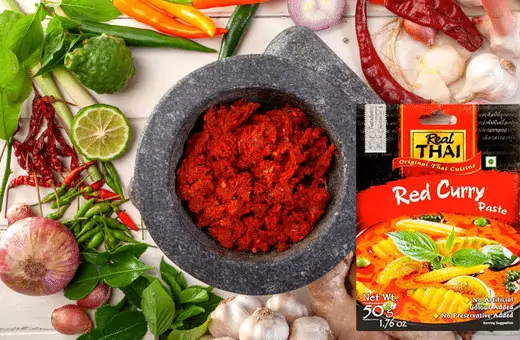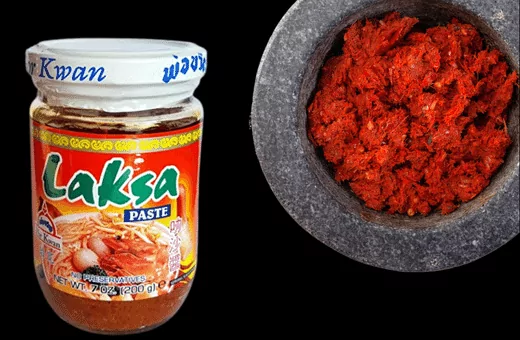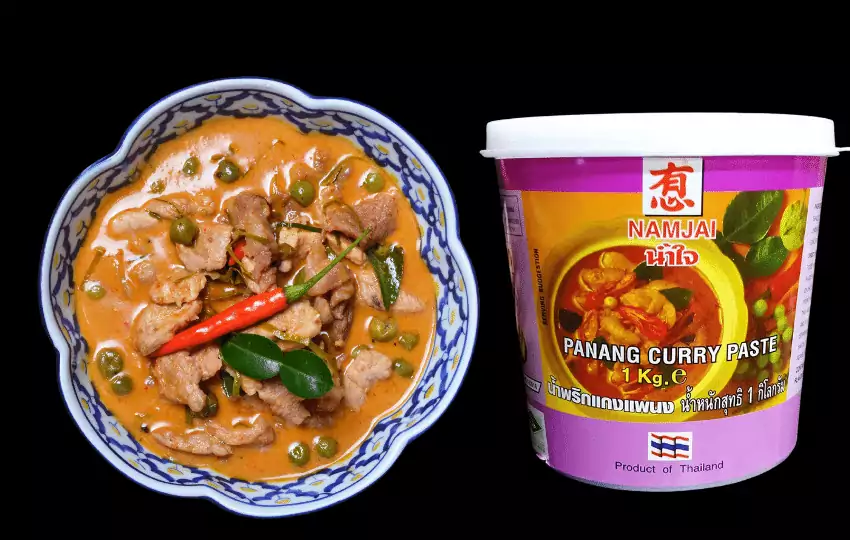When you can’t find Panang curry paste, you can use a combination of red curry paste and Massaman curry paste.
Just mix the two pastes together in equal parts, and you’ll have a similar flavor to Panang curry. You can also add a few ground peanuts to the mix if you want to get closer to the traditional flavor of Panang curry.
What is Panang Curry Paste? What is Panang curry paste made of?
Panang curry paste is a type of Thai curry paste that is made from a variety of ingredients, including dried chili peppers, galangal, lemongrass, cumin seeds, coriander seeds, and shrimp paste.
The paste is typically used to make a type of Thai curry called Panang curry, which is made with coconut milk, beef or chicken, and vegetables.
To make Panang curry paste, the ingredients are first ground into a fine powder using a mortar and pestle or food processor. Then, the powder is combined with water to form a paste. The paste can be stored in a jar or container in the refrigerator for up to two weeks.
When you’re ready to use the paste, simply combine it with coconut milk, beef or chicken, and vegetables in a pot or wok over medium heat. Cook until the meat is cooked through and the vegetables are tender. Serve over steamed rice, and enjoy!
Panang curry paste ingredients
1. 1/2 teaspoon cumin seeds
2. 1/4 teaspoon coriander seeds
3. 1/8 teaspoon black peppercorns
4. 3 dried red chilies, stemmed and seeded
5. 2 cloves garlic, peeled and roughly chopped
6. 1 lemongrass stalk, white part only, roughly chopped
7. 1 teaspoon grated fresh ginger
8. 2 tablespoons peanut oil
9. 2 kaffir lime leaves
10. 1 (13.5 ounces) of coconut milk
11. 1 tablespoon fish sauce
12. 3 tablespoons brown sugar
13. Salt to taste
14. 1/2 cup chopped fresh cilantro leaves
15. 1/4 cup chopped fresh Thai basil leaves
16. Juice 1 lime
To make the Panang curry paste, combine the cumin seeds, coriander seeds, and black peppercorns in a small pan over medium heat. Toast the spices until fragrant, stirring frequently.
Transfer the spices to a spice grinder or mortar and pestle, and grind to a fine powder.
Add the ground spices, dried chilies, garlic, lemongrass, ginger, peanut oil, kaffir lime leaves, coconut milk, fish sauce, brown sugar, and salt to a blender or food processor. Blend until the mixture is smooth.
Stir in the cilantro, Thai basil, and lime juice, and blend briefly to combine. Taste and adjust seasoning as necessary. The Panang curry paste can be stored in a sealed container in the fridge for up to 2 weeks.
What is Panang curry taste like?
Panang curry is a kind of red curry that the dish is usually served with rice and topped with peanuts, making it a hearty and filling meal. As for the taste, Panang curry is known for being spicy and rich in flavor.
The coconut milk infused in the dish gives it a creamy texture, while the red chili peppers provide a fiery kick.
If you enjoy spicy food and are looking for a hearty meal, then Panang curry is definitely worth trying!
What is similar to Panang curry paste?
One ingredient that is often used in Panang curry paste is galangal, which is a type of ginger. Other common ingredients include lemongrass, kaffir lime leaves, cumin, and chili peppers.
When it comes to flavor, Panang curry paste is typically quite spicy and has a bit of a kick to it.
The chili peppers give it a bit of heat, while the lemongrass and kaffir lime leaves add a refreshing citrusy flavor.
The galangal provides a slightly ginger-like taste, while the cumin adds a bit of earthiness.
Overall, Panang curry paste is a flavorful and spicy paste that can be used to make various dishes. If you enjoy curries with a bit of heat, then this paste is definitely worth trying out.
Substitute for Panang Curry Paste
1. Substitute Thai red curry paste for panang
You can substitute Thai red curry for Panang curry paste. This will give the dish a more fiery flavor. If you don’t like your food too spicy, though, you can stick with Panang curry paste.
Thai red curry paste is made with a blend of chili peppers, garlic, lemongrass, galangal, shallots, and shrimp paste. The ingredients are pounded together in a mortar and pestle or ground in a food processor.

The paste is used as a base for Thai red curry and can also be used in other dishes such as stir-fries or soups. It is similar to Panang curry paste but is not as sweet and has a more intense chili flavor.
2. Thai Yellow Curry Paste
Thai yellow curry paste can be used as a substitute for Panang curry paste in many recipes. When substituting, use an equal amount of Thai yellow curry paste as you would Panang curry paste.
Keep in mind that the flavor of your dish may be slightly different with this substitution.
Thai yellow curry paste is made with fresh turmeric, cumin, coriander, galangal, and lemongrass. It is used to make a variety of Thai curries, including Kaeng Kari (yellow chicken curry), Kaeng som pla (fish curry), and Kaeng phet pet yang (duck curry).
The paste is also used in other dishes such as stir-fries, soups, and marinades. It can be added to coconut milk to make a simple curry sauce.
Yellow curry paste is similar to Panang curry paste in that it is made with fresh ingredients and has a strong flavor. However, yellow curry paste is less sweet than Panang curry paste and has a more pronounced turmeric flavor.
Yellow curry paste is readily available in Asian markets and online. It can also be made at home using a food processor or blender.
3. Laksa Paste
Laksa paste is a thick, spicy paste used in Malaysian cuisine. It is made from various ingredients, including chili peppers, galangal, lemongrass, shrimp paste, and spices.
Laksa paste is used to make a popular noodle soup dish called laksa.
Laksa paste can be used as a substitute for Panang curry paste in many recipes. When substituting laksa paste for Panang curry paste, use a 1:1 ratio. So, if the recipe calls for 1 tablespoon of Panang curry paste, use 1 tablespoon of laksa paste instead.
Some recipes may require a bit more or less laksa paste depending on the desired level of spice and flavor, so adjust accordingly.
Laksa paste is typically very spicy, so start with less if you are sensitive to spice. You can always add more, but you can’t take it away once it’s been added.
If you can’t find laksa paste at your local grocery store, you can order it online. Or, you can make your own laksa paste at home using this recipe.
· Galangal
· Dried chilies
· Garlic
· Turmeric
· Cumin seeds
· Coriander seeds
· Shrimp paste/ dried shrimps
Laksa paste is similar to Panang curry paste in that it is thick and spicy. However, laksa paste contains more chili peppers and shrimp paste, giving it a more intense flavor.
Laksha paste has the extra advantage of providing a comparable hue when substituted.
Ginger could be used to simulate the flavor of galangal. Because of the number of red chilies utilized, this may be a little spicier than our subject leader.
As a result of its rich flavor profile, this will not be a suitable substitute for conventional Thai yellow curries. However, it will go well with various other curries, marinades, stir-fries, and so on.
It is used in many different dishes, including laksa soup, nasi lemak (coconut rice), and Mee Goreng (fried noodles).
If you cannot find laksa paste at your local grocery store, you can easily make it at home.
To make laksa paste, simply combine all of the ingredients in a food processor or blender and blend until smooth. Laksa paste can be stored in the refrigerator for up to one month.

Homemade Phanaeng Paste (The best Panang curry paste )
The best Panang curry paste is the one that you make yourself. While there are many good commercial brands available, nothing beats the flavor of a homemade paste. If you like to try your hand at making your own Panang curry paste, here is a recipe to get you started:
Ingredients:
- 1 tablespoon cumin seeds
- 1 tablespoon coriander seeds
- 2 teaspoons fennel seeds
- 6-8 dried red chilies, seeded and broken into pieces
- 3 cloves garlic, peeled and chopped
- 1 teaspoon grated ginger
- 2 lemongrass stalks, trimmed and chopped
- 1 shallot, peeled and chopped
- 2 tablespoons shrimp paste
- 1 tablespoon fish sauce
- 2 teaspoons sugar
- 1 teaspoon salt
- 1/4 cup (60 ml) coconut milk
To Make the Paste:
1. Toast the cumin, coriander, and fennel seeds in a dry pan over medium heat until they are fragrant.
2. Place the toasted spices, along with the red chilies, garlic, ginger, lemongrass, shallot, shrimp paste, fish sauce, sugar, and salt in a food processor or blender and process until everything is finely chopped and combined into a paste.
3. Add the coconut milk and process it again until smooth.
4. The paste can be stored in a tightly sealed container in the refrigerator for up to 2 weeks.
To use the paste, simply stir it into coconut milk or water to make a curry sauce. It can also be used as a marinade for meat or vegetables before cooking. Enjoy!
However, there is no definitive answer to this question as it depends on personal preferences. Some people might prefer a brand that is fierier, while others might prefer one with a more coconutty flavor.
Read more: Substitute for Kohlrabi
Ultimately, it is up to the individual to decide what brand of a Panang curry paste they think tastes the best. Some popular brands of Panang curry paste include Mae Ploy, Aroy-D, and Maesri.
What is the difference between Thai Red Curry and Panang Curry Paste?
When it comes to Thai Red Curry and Panang Curry Paste, there are a few key differences that set them apart.
For starters, Thai Red Curry is typically made with red chili peppers, whereas Panang Curry Paste is made with dried chili peppers.
As a result, Thai Red Curry has a slightly spicier flavor than Panang Curry Paste.
Additionally, Thai Red Curry is typically made with coconut milk, whereas Panang Curry Paste is made with peanut butter. This gives Thai Red Curry a richer, creamier texture than Panang Curry Paste.
Finally, Thai Red Curry is often served with rice, whereas Panang Curry Paste is typically served with noodles.
So, what’s the bottom line? If you’re looking for a spicier, more flavorful curry paste, then Thai Red Curry is the way to go.
However, if you prefer a milder curry paste with a creamier texture, then Panang Curry Paste may be more your speed. Whichever curry paste you choose, you’re sure to enjoy a delicious, authentic Thai curry dish!
Read More: Famous alternative for Pernod
FAQs on the replacement for Panang curry paste
Q1. Is red curry paste the same as Panang?
No, red curry paste and Panang curry paste are not the same. Red curry paste is made with red chilies, while Panang curry paste is made with dried, ground chilies. They both have different flavor profiles, with red curry being spicier and Panang being more savory.
Q2. Where to buy Panang curry paste?
The best place to buy Panang curry paste is at a local Asian market. You can also find it online at Amazon.com or other retailers.

